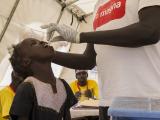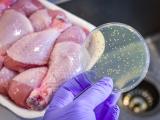Aug 28, 2008 (CIDRAP News) – Federal officials today lifted their warning about eating raw jalapeno and Serrano peppers from Mexico and said the nation's largest foodborne illness outbreak, which was linked to an uncommon Salmonella strain, appears to be over.
At a media teleconference today, Robert Tauxe, MD, MPH, deputy director of the Centers for Disease Control and Prevention's (CDC's) Division of Foodborne, Bacterial and Mycotic Diseases, said the CDC and state health departments would continue to conduct surveillance for more infections with the Salmonella enterica serotype Saintpaul outbreak strain.
He told reporters that public health officials expect to see a few more cases. In August, however, the number of new Salmonella Saintpaul illnesses has dropped to a level that officials typically expect to see outside of an outbreak setting.
"Also, the last cluster was reported in early July, which is another important indicator that the outbreak is over," Tauxe said.
David Acheson, MD, commissioner for foods at the US Food and Drug Administration (FDA), said the FDA's decision to cancel its hot pepper warning is consistent with an outbreak ending, but it also reflects the completion of the field investigations and the fact that peppers from two Mexican farms implicated in the outbreak are no longer in circulation.
He said the FDA has stepped up surveillance of produce coming across the border from Mexico and that some shipments have been turned back because some were contaminated with Salmonella, but not the national outbreak strain.
Outbreak report released
Officials from the CDC and FDA also released an initial epidemiologic report on the outbreak, which appears in tomorrow's issue of Morbidity and Mortality Weekly Report (MMWR). As of Aug 25, 1,442 cases have been linked to the outbreak, which has sickened patients in 43 states, the District of Columbia, and Canada.
So far at least 286 patients have been hospitalized. No deaths have been connected directly to the outbreak, but officials said illnesses may have contributed to the death of two older Texas men who had preexisting medical conditions.
The outbreak began in April, but most of the illnesses occurred in May and June.
Tauxe said officials still suspect that contaminated tomatoes played a role earlier in the outbreak, but said microbiologic and epidemiologic findings revealed jalapeno and Serrano peppers as the sources. According to the MMWR report, the first case-control study, which was conducted in mid May and involved patients in New Mexico, Texas, and the Navajo Nation, showed that infections were significantly associated with raw tomatoes, but not with salsa or guacamole.
A month later, a Texas case cluster investigation revealed a connection between illnesses and eating salsa, which included raw tomatoes and raw jalapeno peppers.
The first indication that peppers were a primary Salmonella source came in late June, when another case cluster study showed a connection to eating salsa at a local Mexican restaurant chain in Texas. The salsa was made from canned tomatoes and raw jalapenos. The following week, officials from the Minnesota Department of Health investigated another case cluster that linked illnesses only to raw jalapeno peppers.
In July, investigation of a case cluster in North Carolina revealed an association with guacamole, but it contained Serrano peppers, not jalapenos. "This study demonstrated that not all of the outbreak illnesses could be linked to eating jalapeno peppers," the CDC authors wrote.
Tauxe said though multi-vehicle outbreaks are rare, they have occurred before, such as an outbreak in 1998 that involved both parsley and cilantro grown on the same farm.
According to details about the trace-back investigation in the MMWR report, FDA officials traced jalapenos from Texas case clusters to a distributor in McAllen, Tex., where they found a positive jalapeno sample, and then to a farm in Tamaulipas state, in Mexico, that also grew Serrano peppers and Roma tomatoes. Though FDA officials didn't isolate the outbreak strain from that farm, they did find the pathogen on a Serrano pepper and in irrigation water on another farm from the same state. The second farm grew only jalapeno peppers.
Contamination mechanism still unknown
Officials still haven't determined the contamination mechanism. Tauxe said contamination could have occurred on the farm or during distribution. According to the MMWR report, both farms used the same packing facility that exports produce to the United States.
Acheson told reporters that the two farms are about 100 miles away from each other and that cattle grazed nearby, though investigators haven't determined if the animals were a contamination source.
In an editorial comment that appeared with the report, CDC authors didn't rule out the possibility of multivehicle contamination. "Finding the outbreak strain on two types of peppers from two farms supports the possibility of contamination of other produce items, including tomatoes, during growing, processing, or distribution," they wrote.
Acheson said health officials are learning several important lessons from the outbreak, but that several specific measures could help prevent future produce outbreaks. He said Congress should give the FDA the authority to regulate high-risk products and that technological advancements could help inspectors detect pathogens more quickly. Better tracking systems from the food industry could help speed trace-back investigations, and federal agencies can improve their outbreak response systems.
CDC. Outbreak of Salmonella serotype Saintpaul infections associated with multiple raw produce items—United States, 2008. MMWR 2008 Aug 29;57(34):929-34 [Full text]
See also:
Aug 21 CIDRAP News story "Officials say Salmonella outbreak winding down"
Jul 30 CIDRAP News story "Salmonella outbreak strain traced to Mexican farm"
Jul 24 CIDRAP News story "Minnesota tactics helped reveal Salmonella source"
















